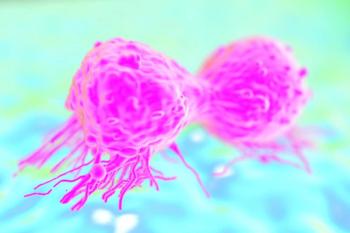
- ONCOLOGY Vol 15 No 1
- Volume 15
- Issue 1
Commentary (Danforth): Breast Cancer During Pregnancy
The care of a pregnant breast cancer patient is a challenging clinical situation that historically has placed the welfare of the mother in conflict with that of the fetus. For the woman in this situation, the emotions usually
Although the incidence of breast cancer in women increases with age, and its occurrence is uncommon before age 30 years, approximately 22,000 cases (12%) are reported annually in the United States for women in their child-bearing years.[1] Moreover, many women today are deferring childbirth until the 4th or 5th decades of life, thus increasing the potential that these two processes might overlap.
Breast cancer during pregnancy is a particularly difficult problem because of delays in diagnosis, potential stimulation by the enhanced hormonal levels associated with pregnancy, difficulties in management, and the often poorer prognosis resulting from a more advanced stage at presentation. In this issue of Oncology, Drs. Gwyn and Theriault present an excellent review of breast cancer in pregnancy, clarifying our current understanding of many of these issues, and providing important guidelines for future management.
Hormonal Factors in Pregnancy-Associated Breast Cancer
The median age of women with breast cancer during pregnancy in five series was 33 years,[2-6] which is considerably younger than the median age (40 to 44 years) of premenopausal women with breast cancer who are not pregnant.[1] Breast cancer has a wide spectrum of receptors for steroid hormones, growth factors, and other mitogens, including estrogens, progestins, insulin-like growth factor, transforming growth factor-alpha, and epidermal growth factor. Concomitant plasma levels of estrogens and other hormones rise significantly during pregnancy, and, it would seem, increase the likelihood of an enhanced growth state for breast cancer. It is thus possible that these factors play a role in earlier onset, and induce changes in the breast parenchymal and stromal tissue that complicate diagnostic and staging evaluations.
Receptor modulation of breast cancer during pregnancy is poorly understood. Many of these hormonal elevations also develop and sustain the fetus, and as the authors point out, this precludes antiestrogen therapy or other hormonal manipulation in these women. These observations, at the same time, illustrate the need for targeted therapy of breast cancer that spares other tissues and organs.
Physiologic Changes
Marked physiologic changes occur in the breast during pregnancy, including enhanced ductal-alveolar-lobular growth, increased mammary blood flow, and increased interstitial fluid and electrolyte content.[7] The subtle changes within the breast and in the skin may thus be more difficult to detect, resulting in a delay in diagnosis. Pregnancy-associated masses in the breast are usually discovered by the patient, and although not emphasized by the authors, all women should be encouraged to practice breast self-examination during pregnancy.
Screening and Staging Procedures
Once a mass is detected, ultrasound will delineate a solid from cystic character. If the mass is solid, a core-needle biopsy should be obtained (the rare likelihood of a milk-producing fistula notwithstanding). Aspiration cytology may indicate a malignancy; however, it has been shown that estrogens can induce a variety of proliferative changes in benign breast epithelial cells, including atypical hyperplasia and carcinoma in situ, as well as invasive carcinoma.[8] One may, thus, be reluctant to plan definitive therapy of a breast mass based on aspiration cytology alone.
Mammography may further define the lesion as well as the remaining ipsilateral and contralateral breast parenchyma; however, no finding on mammography should discourage obtaining a definitive diagnosis of a solid tumor.
Accurate staging and the determination of locoregional and systemic treatment options for breast cancer during pregnancy are difficult. Drs. Gwyn and Theriault emphasize that many of these women present with advanced disease. Identifying advanced skin changes, including erythema and edema, may be difficult. Any questionable change should be clarified with a skin punch biopsy.
The authors recommend evaluating regional adenopathy with ultrasound and fine-needle aspirate. In the case of supraclavicular adenopathy, this is clearly important. For axillary adenopathy, even with positive cytology, this is not apt to change management, and if negative, is of no value. Fine-needle aspiration would be relevant only for axillary adenopathy related to an unknown primary. Alternatively, sentinel lymph node biopsy is being used increasingly in breast cancer patients who are not pregnant for evaluation of stage I/II tumors.
There are several concerns, however, about its use in pregnant patients because of the potential risk from technetium radiolabeling, possible allergic reactions to the blue dye, unknown physiologic changes accompanying decreased pulse oximetry with use of the blue dye, and possibly altered lymphatic drainage in the lactating breast.
At the same time, in four series, the incidence of axillary metastases in breast cancer during pregnancy was approximately 60% (range: 56% to 67%).[3-5,9] It can thus be argued that all women presenting with breast cancer during pregnancy should have an axillary lymph node dissection.
Treatment Options
The authors present an excellent review of treatment options for breast cancer in pregnancy. Modified radical mastectomy is the recommended management for the majority of women. In selected cases presenting later in the third trimester, when the normal sequence of chemotherapy and radiotherapy would place the delivery of the radiation well into the postpartum period, breast-conserving therapy may be an option. In such cases, radiotherapy could be delivered safely, although this may interfere with lactation.
For women undergoing mastectomy, reconstruction surgery might preferably be delayed until after complete recovery from the delivery so that all of the reconstruction options, especially myocutaneous flaps, can be adequately evaluated. Reconstruction with a tissue expander during pregnancy is feasible, but there may be limitations in assessing symmetry with the other breast and achieving the desired cosmetic result. Failure to perform immediate reconstruction generally precludes the use of a skin-sparing type of mastectomy.
Management of locally advanced breast cancer, especially in women presenting during the first trimester, poses several dilemmas. As the authors discuss, staging procedures to evaluate sites of visceral disease are limited by potential toxicity to the fetus. The limited ability to identify sites of distant disease may also have an indirect impact on the ability to assess response to chemotherapy. At the same time, the duration of chemotherapy for stage III/IV breast cancer is characteristically longer than for an adjuvant regimen, increasing the potential for an adverse effect on the fetus, the conduct of the pregnancy, and the labor and delivery.
Furthermore, there is no published experience with the use of more aggressive regimens in pregnancy such as those often used in the treatment of stage III/IV breast cancer, thus limiting treatment options further. For women presenting with these poor-prognosis tumors, the decision to interrupt a pregnancy so as to maximize local and systemic treatment options can be difficult.
Subsequent Pregnancies
Counseling women about the advisability of a subsequent pregnancy must take into account the prognosis of the previous breast cancer, the potential influence of a subsequent pregnancy on this breast cancer, and a variety of psychosocial issues. In a review of 465 cases by this author,[10] it was shown that, following successful treatment of a breast cancer, a subsequent pregnancy does not alter the overall survival for that tumor, and this is independent of stage, axillary lymph node involvement, and the number of pregnancies. This is supported by subsequent reviews, as indicated by Drs. Gwyn and Theriault in their article.
Nevertheless, once a woman has experienced a breast cancer during pregnancy, she may be understandably reluctant to risk this situation again. The article by Drs. Gwyn and Theriault makes clear that an understanding of the multiple components of a breast cancer during pregnancy is necessary for effective management of these women. Moreover, this article lays the groundwork for that understanding, and serves as an excellent resource for all health-care workers involved in the care of these women.
References:
1. Ries L, Miller BA, Hankey BF, et al (eds): SEER Cancer Statistics Review 1973-1988: Tables and Graphs, p 119. National Cancer Institute, NIH Publication 94-2789, 1991.
2. Anderson BO, Petrek JA, Byrd DR, et al: Pregnancy influences breast cancer stage at diagnosis in women 30 years of age and younger. Ann Surg Oncol 3:204-211, 1996.
3. Ishida T, Yokoe T, Kasumi F, et al: Clinicopathologic characteristics and prognosis of breast cancer patients associated with pregnancy and lactation: Analysis of case-control study in Japan. Jpn J Cancer Res 83:1143-1149, 1992.
4. Bonnier P, Romain S, Dilhuydy JM, et al: Influence of pregnancy on the outcome of breast cancer: A case-control study. Int J Cancer 72:720-727, 1997.
5. Berry DL, Theriault RL, Holmes FA, et al: Management of breast cancer during pregnancy using a standardized protocol. J Clin Oncol 17:855-861, 1999.
6. Zemlickis D, Lishner M, Degendorfer P, et al: Maternal and fetal outcome after breast cancer in pregnancy. Am J Obstet Gynecol 166:781-787, 1992.
7. Vorherr H: Hormonal and biochemical changes of pituitary and breast during pregnancy. Semin Perinatol 3:193-198, 1979.
8. Shekhar MP, Nangia-Makker P, Wolman SR, et al: Direct action of estrogen on sequence of progression of human preneoplastic breast disease. Am J Pathol 152:1129-1132, 1998.
9. Gemignani ML, Petrek JA, Borgen PI: Breast cancer and pregnancy. Surg Clin North Am 79:1157-1169, 1999.
10. Danforth DN Jr: How subsequent pregnancy affects outcome in women with a prior breast cancer. Oncology 5:23-30, 1991.
Articles in this issue
almost 25 years ago
Perspectives on the Use of Fluorinated Pyrimidinesalmost 25 years ago
Nursing Strategies for Patients on Oral Chemotherapyalmost 25 years ago
Capecitabine in Colorectal Canceralmost 25 years ago
UFT in the Treatment of Colorectal and Breast Canceralmost 25 years ago
Clinical Status of Capecitabine in the Treatment of Breast Canceralmost 25 years ago
Patient Selection for Oral Chemotherapyalmost 25 years ago
Other Fluorinated Pyrimidines in the Treatment of Solid TumorsNewsletter
Stay up to date on recent advances in the multidisciplinary approach to cancer.



















































































